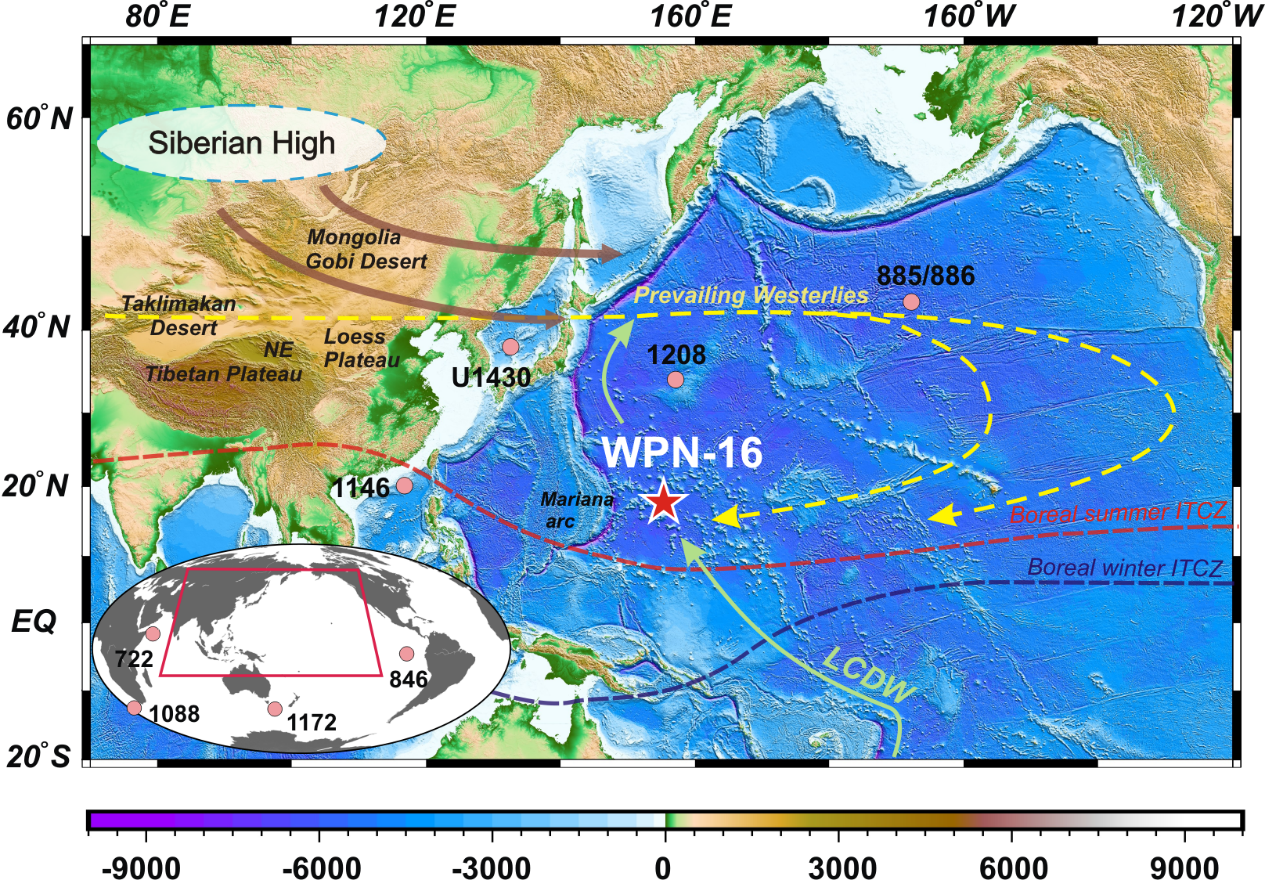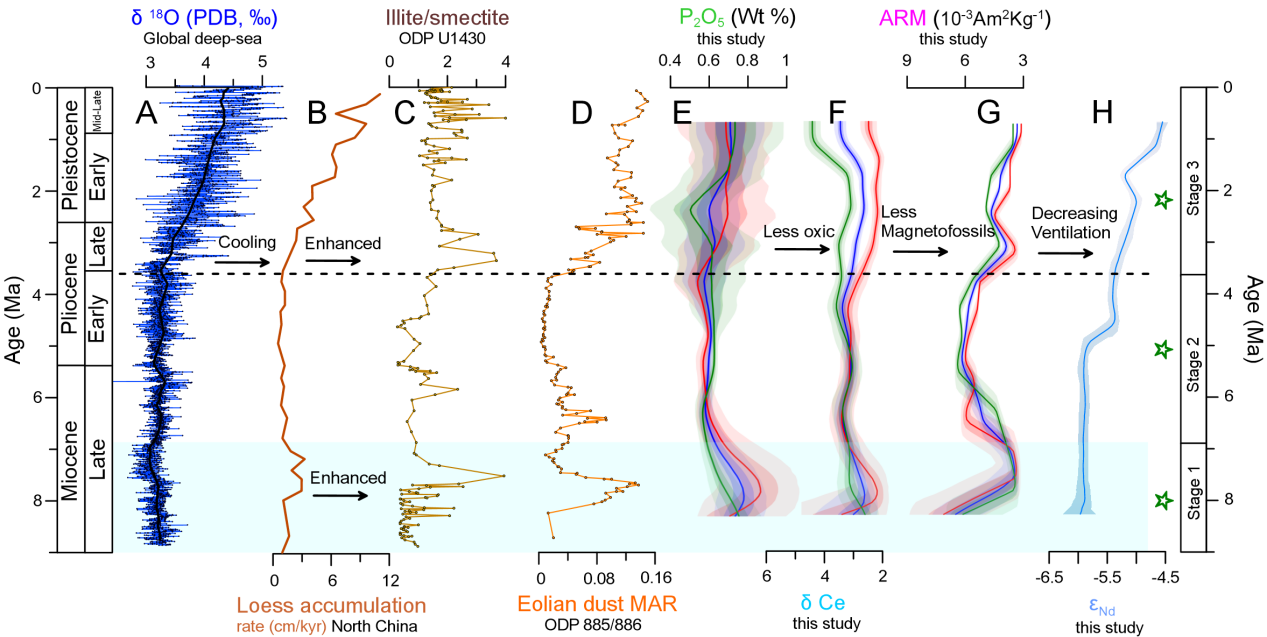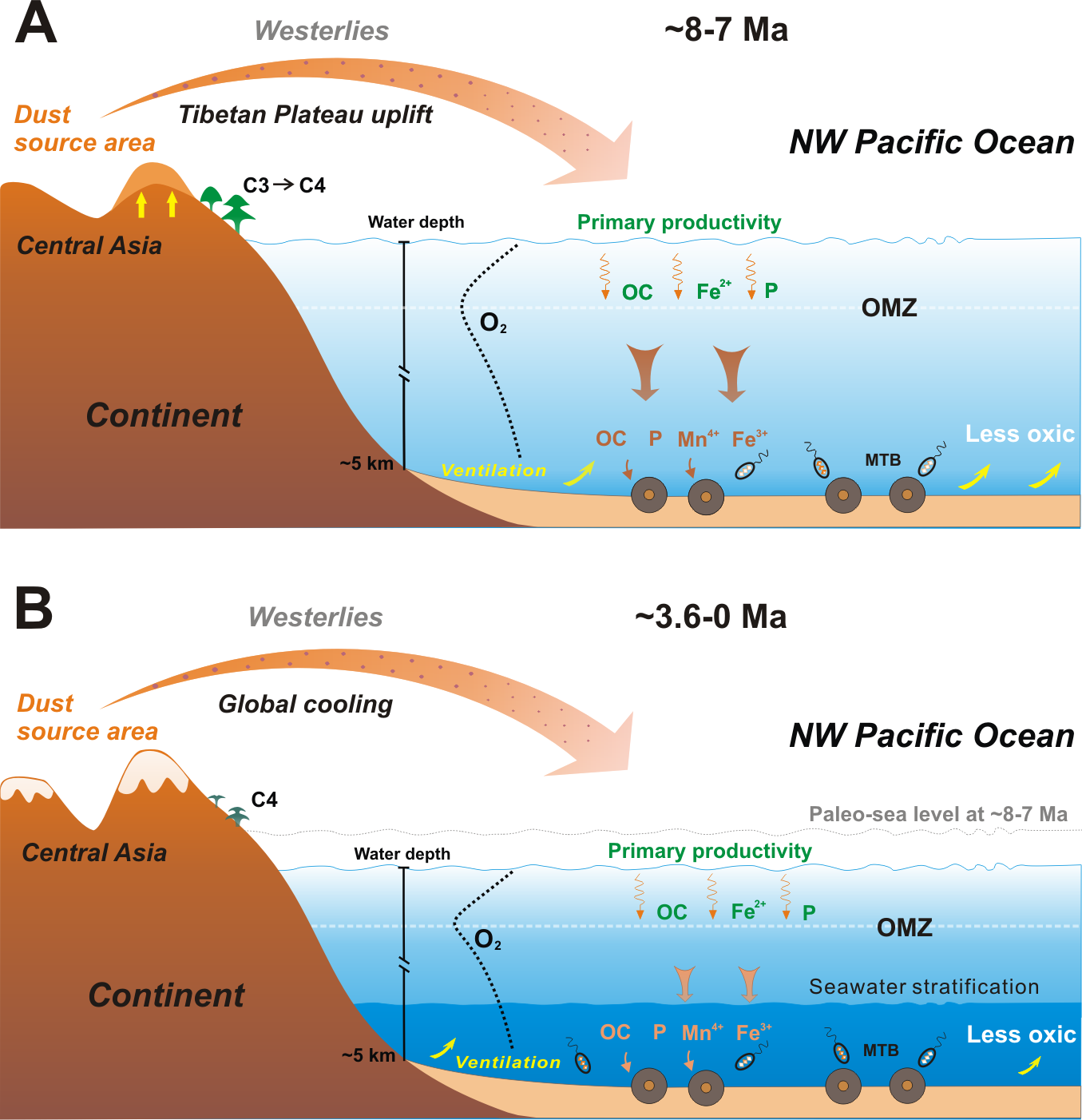Dust is an important product of the interaction between the earth’s surface and atmosphere and plays an essential role in the long-term evolution of climate and the environment. Dust transported to the ocean over long distances can provide nutrients such as iron to the ocean, improve marine productivity, and promote photosynthesis and atmospheric carbon dioxide sequestration.
This process is a critical factor in regulating the global carbon cycle and climate change. Central Asia is one of the most important dust source regions on earth. The North Pacific is located on the main axis of westerlies, and the environmental change impacted by dust is very significant. However, the records of Asian dust in the North Pacific since the Late Miocene are inconsistent, and the impact of dust on productivity is also controversial.

Researchers from the Centre for Marine Magnetism (CM2) of the Department of Ocean Science and Engineering at the Southern University of Science and Technology (SUSTech) have made new progress in the paleoclimate of abyssal manganese nodules from the North West (NW) Pacific. It reveals the central Asian aridification caused by the uplift of the Tibetan Plateau and the global cooling since the Late Miocene. Their research, entitled “Abyssal manganese nodule recording of global cooling and Tibetan Plateau uplift impacts on Asian aridification,” was published in Geophysical Research Letters.

Figure. 1. Map of research area. The red star indicates the sampling site, and circles and diamonds indicate the locations of reference sites mentioned in the text. Yellow dashed lines indicate the prevailing westerlies. Green lines represent the pathway of the lower circumpolar deep water (LCDW) (Rella & Uchida, 2015). Red and black dashed lines indicate the positions of the boreal summer and winter intertropical convergence zone, respectively.
The Western Pacific Ocean is far away from the mainland and has little input of terrestrial materials, resulting in extremely low productivity. However, this area is located at the end of the main westerly axis, which is theoretically very sensitive to dust input. In addition, a large number of manganese nodules and crusts are widely distributed in this area. These sedimentary minerals record abundant information of paleoenvironment and palaeoclimate, and are the information repository of the biogeochemical cycle. They are the ideal medium for studying environment response in the western Pacific.
CM2 conducted systematic geochemical, rock magnetiism, and paleoceanographic studies on the manganese nodules from the low latitude area of the Western Pacific Ocean, to establish a chronological framework, and extract paleo-environmental and microfossil information. It was found that manganese nodules in the Western Pacific records dust inputs from Asia, which affected marine productivity and benthic microbial activity. Progress has been listed in the following three aspects:

Figure. 2. Deep-sea video recording of marine manganese nodules. (a-c) figures of manganese nodule profile, deep-sea nodule figure, and representative hand specimen.
Improving the method of dating
Co chronology and Be isotopic combination is the most common method used for ferromanganese nodules and crusts dating. Multiple Co chronology empirical formulae have been developed in the past several decades, implying that we can build up different age models for one sample based on these empirical formulas. It is challenging to identify which age model is the best one. To resolve this problem, the researchers provide a general formula of Co chronology in this study. Constrained by Be isotope absolute age and calculation based on the Bayesian method, they finally built up a reliable age framework.
Multiple indicators are used to determine the central Asian aridification
Geochemical and rock magnetism results show that manganese nodules recorded two significant intensified dust input events ~8-7 Ma and ~3.6-0 Ma since the Late Miocene (Fig. 3). Significant productivity increase (P), Redox change (δCe), and magnetofossils content (ARM) change are observed in these two periods. These results indicate that the iron fertilizer effect of dust input has a positive effect on productivity in the low latitude area of the western Pacific Ocean. The input of organic matter to the deep sea affects the seafloor state, and magnetotactic bacteria is sensitive to the redox state.

Figure 3. Comparison of global and regional climate records with geochemical and magnetic data across the studied nodule (a) Benthic foraminiferal δ18O record of global climate change. (b) Loess accumulation rate in Qinan, North China. (c) Japan Sea Asian eolian dust flux based on illite/smectite fluxes. (d) Eolian dust mass accumulation rate from ODP Site 885/886. (e-g) Bulk P2O5 and redox proxy (δCe) across the nodule. Anhysteretic remanent magnetization proxy for the relative magnetofossil abundance in nodule slices. (h) εNd proxy for bottom water ventilation variations during nodule formation.
Identifying Asian aridification driver since the Late Miocene
The driving mechanism of Asian aridification since the Late Miocene is still in controversy between global cooling and Tibetan plateau uplift. This is because the Tibetan plateau uplift may prevent water vapor from the Indian Ocean from entering Asian inland, and global cooling can cause water vapor transmission to the polar ice caps. In this study, the researchers analyzed global oceanic productivity since the Late Miocene. It is noted that the enhanced productivity is observed in the Asia marginal Seas and the North Pacific during ~8-7 Ma, while the enhanced productivity has been observed in the global oceans since 3.6 Ma. This suggests that these two events may results from regional and global drivers, respectively. They are related to the uplift of the Tibetan Plateau and global cooling, respectively.

Figure 4. Conceptual model for links between climate change and abyssal microbial activity for two scenarios (OMZ = oxygen-minimum zone, OC = organic carbon) (a) Central Asian aridification due to NE Tibetan Plateau uplift at ∼8–Ma. Enhanced eolian input to the NW Pacific triggered increased primary productivity, which decreased seafloor oxygenation due to increased organic matter degradation. This environmental change impacted magnetotactic bacteria biomineralization. (b) Central Asian aridification due to global cooling since ∼3.6 Ma. The same link from Asian aridification to abyssal NW Pacific microbial activity also occurred during this period. Organic matter and nutrient input to the seafloor may have also been restrained by ocean stratification, with vegetation dominated by C4 plants during this period.
Based on a systematic study of manganese nodules in the Western Pacific, this study revealed that the uplift of the Tibetan Plateau and global cooling since the Late Miocene intensified the aridity of the Asian inland. The enhanced dust flux affected the productivity, deep-sea redox, and benthic microbial activities of the Western Pacific through the iron fertilizer effect. This research provides a new perspective for studying the coevolution of Asian inland aridity and the Pacific environment.
Xiaodong Jiang, Research Assistant Professor from the Department of Ocean Science and Engineering at SUSTech, is the first author of this paper. Assistant Prof. Yu-Min Chou and Chair Prof. Qingsong Liu from SUSTech are the corresponding authors. Other cooperating institutes included the Australian National University (ANU), the U.S. Geological Survey, and the National Institute of Polar Research of Japan.
This work was supported by the National Natural Science Foundation of China (NSFC), the National Key R & D Program of China, Shenzhen Science and Technology Program, and the Australian Research Council. This research used samples provided by COMRA.
Paper link: https://doi.org/10.1029/2021GL096624
To read all stories about SUSTech science, subscribe to the monthly SUSTech Newsletter.
Proofread ByAdrian Cremin, Yingying XIA
Photo By